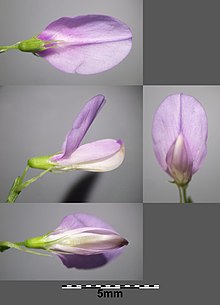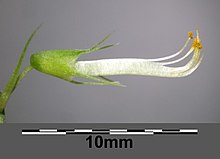Hawk
| Hawk | ||||||||||||
|---|---|---|---|---|---|---|---|---|---|---|---|---|

Goat's Rue ( Galega officinalis ) |
||||||||||||
| Systematics | ||||||||||||
|
||||||||||||
| Scientific name | ||||||||||||
| Galega officinalis | ||||||||||||
| L. |
The goat's rue ( Galega officinalis ), also known as common goat's rue, buckhorn, spotted herb, goat's clover, smallpox, addictive herb, goat's rue, is the only plant species of the genus Galega native to Central Europe and belongs to the subfamily of butterflies (Faboideae) within the legume family (Fabaceae) .
description
Vegetative characteristics
The goat's rue is a perennial herbaceous plant . It forms beet-like roots. The up to 1 meter high stems are hollow and grooved. The alternate leaves are pinnate unpaired. The 9 to 17 leaflets are 3 to 9 mm wide and have striated veins. Stipules are present.
Generative characteristics
The flowering period in Europe extends from summer to autumn. Up to 50 flowers stand in a dense, stalked racemose inflorescence .
The pink-red, bluish or white, 9 to 15 mm large, zygomorphic flowers are veined purple. The flower cover consists of two small wings, a flag and a boat made of two overgrown petals . The flower has nine stamens grown together on the filaments and one free stamen. The carpel is on top.
The legumes , up to 3 centimeters long, contain flat, brown seeds.
The number of chromosomes is 2n = 16.
Ecology and toxicity
The common goat's rue is a hemicryptophyte . The real goat's rue is considered a pasture for bees . It is a food source for the caterpillar of Coleophora vicinella from the family of the mini- bag- bearers or bag-carrier moths (Coleophoridae).
The plant is poisonous to mammals and fatal poisoning of grazing cattle has been observed. All parts of the plant are poisonous; the toxicity level is highest during the flowering period and fruiting. The toxins are retained even when drying. According to Madaus , symptoms of poisoning have been reported in grazing animals during the flowering period, on the other hand, increased milk yields have been noted, and according to Camerarius even increased egg-laying in chickens.
Occurrence
The natural range of the goat's rue is the eastern Mediterranean, southern central Europe, southern and eastern Europe to the Middle East .
It was cultivated as a fodder plant in western and southern Italy . In the past, this species was often grown as a medicinal and ornamental plant and has been continually wild in areas since the 19th century. In some countries it is considered an invasive plant .
It grows in areas with a mild climate on moist, loamy meadows as well as on stream banks and in alluvial forests . In its natural range it is a character species of the order Convolvuletalia, but also occurs in plant communities of the Agropyro-Rumicion association.
Taxonomy
The first publication of Galega officinalis was done by Carl von Linné . The botanical genus name Galega is said to be derived from the Greek word gála for milk and ágein for to drive. The specific epithet officinalis denotes plant species with a medicinal effect. Synonyms for Galega officinalis are: Accoromba tricolor , Callotropis tricolor , Galega bicolor Boiss. & Hausskn. ex rule , Galega patula Steven , Galega persica Pers. , Galega vulgaris Lam. , Galega coronilloides
Use as a medicinal plant
Madaus calls it an unresolved issue whether ancient doctors knew the plant, but it apparently remained unknown in Italy until the early Middle Ages and in Germany until the 15th century. H. Bock and L. Fuchs did not even mention it, Gesner and Camerarius on the other hand did, around 1600 it had already been cultivated for medicinal purposes in many German gardens. It was especially recommended as a diuretic and sweaty, against worms, digestive and metabolic disorders, skin diseases, epilepsy and poisoning. According to later studies, the ingredient galegin acts similarly to guanidine against diabetes mellitus , and to a lesser extent against diabetes insipidus . For example, Janson recommends a tea made from goat's rue, bean pods and cone winter love for slightly ill diabetics .

The drug is called Galegae herba, Herba Galegae, or Herba Rutae capriariae ; the dried above-ground parts of the plant collected during the flowering period are used.
Extracts of the goat's rue contain, as essential ingredients, the alkaloid galegine, a guanidine - derivative , and further the glycoside Galuteolin, tannins, saponins and bitter substances. Studies prove the milk-promoting and blood-sugar-lowering effects of Galega officinalis. The active ingredient is used in homeopathy for insufficient milk flow in women who have recently given birth.
Common names
The other common German-language names exist or existed for the goat's rue: Bakraute, Fleckenkraut, Heydenkraut ( Middle High German ), Pestilenzkraut, Petechienkraut, Pockenraute (Middle High German), Suchtkraut (Middle High German) and Ziegenraute (Middle High German).
More pictures
Individual evidence
- ↑ a b Erich Oberdorfer : Plant-sociological excursion flora for Germany and neighboring areas. 8th edition. Verlag Eugen Ulmer, Stuttgart 2001, ISBN 3-8001-3131-5 , p. 600.
- ↑ a b Gerhard Madaus: Textbook of biological remedies. Volume II. Olms, Hildesheim / New York 1979, ISBN 3-487-05891-X , pp. 1402-1407 (reprint of the Leipzig 1938 edition).
- ^ [1] W. Arnold, Heilpflanze, accessed on October 16, 2011
- ^ Georg August Pritzel , Carl Jessen : The German folk names of plants. New contribution to the German linguistic treasure. Philipp Cohen, Hannover 1882, p. 157, archive.org
literature
- H. Heiss: Vienna Medical Weekly (24/1968)
- RF Weiss: Phytotherapy , Hippokrates Verlag Stuttgart (1985)
Web links
- Galega officinalis L., common goat's rue. In: FloraWeb.de.
- Hawk . In: BiolFlor, the database of biological-ecological characteristics of the flora of Germany.
- Profile and distribution map for Bavaria . In: Botanical Information Hub of Bavaria .
- Galega officinalis L. In: Info Flora , the national data and information center for Swiss flora . Retrieved November 18, 2015.
- Thomas Meyer: Data sheet with identification key and photos at Flora-de: Flora von Deutschland (old name of the website: Flowers in Swabia ).
- The goat's rue as a "medicinal plant".
- Galega officinalis as an invasive plant species in North America at USDA. (engl.)







